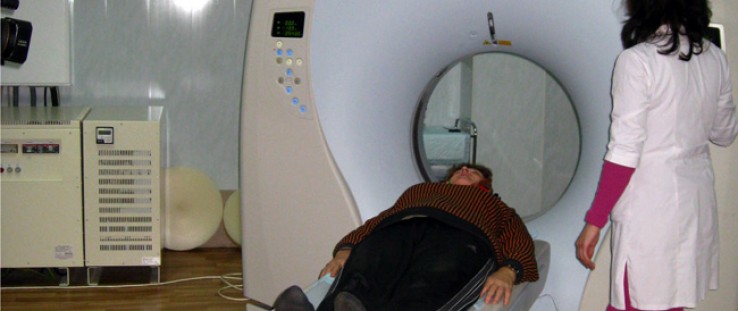 Purchase of hospital equipment in Zhytomyr, such as the computer tomographic system used for radiodiagnostics, was made possible through Ukraine’s new budget system.
CREDIT: OLENA PANCHENKO, IBSER
Purchase of hospital equipment in Zhytomyr, such as the computer tomographic system used for radiodiagnostics, was made possible through Ukraine’s new budget system.
CREDIT: OLENA PANCHENKO, IBSER
 Purchase of hospital equipment in Zhytomyr, such as the computer tomographic system used for radiodiagnostics, was made possible through Ukraine’s new budget system.
CREDIT: OLENA PANCHENKO, IBSER
Purchase of hospital equipment in Zhytomyr, such as the computer tomographic system used for radiodiagnostics, was made possible through Ukraine’s new budget system.
CREDIT: OLENA PANCHENKO, IBSER
“Not a single kopek of the city budget will be stolen from Kyiv citizens,” wrote Oleksander Popov, head of the Kyiv City State Administration, on the city’s website. “[With the new budget system] we are going to put our financial system in order and eliminate any chance for budget abuse.”
The new budgeting system, known as Performance Program Budgeting (PPB), represents a new, more effective way of doing municipal business, according to Popov, who describes Ukraine’s current system, a vestige from the Soviet Union, as one that “focuses on cultivating bureaucracy, rather than on improving services to Kyiv residents.”
For Kyiv, as well as 117 other municipalities where PPB has been piloted since 2008, the status quo is changing. Once viewed with skepticism by officials in the post-Soviet nation, the new system, which allows for more efficient and transparent spending of resources, is being rolled out nationwide over the next three years, thanks to USAID assistance.
Linking Resources to Results
Early skepticism vanished for one reason. According to Iryna Shcherbyna, director general of the Institute for Budgetary and Socio-Economic Research (IBSER), a Ukrainian NGO partnering with USAID, “PPB establishes clear priorities for budgetary expenditures. It transforms general budget line items into concrete goals and tasks, expressed in simple and clear indicators.” Using a performance-based methodology establishes a clear link between resources and results, allowing local governments to spend scarce resources more wisely.
Related Content
Ukraine’s Institute for Budgetary and Socio-Economic Research
The old line-item budgeting method is still used for the preparation of some local budgets in Ukraine. It mandates line items in budgets—for things like salaries and utilities—without considering achieved results or customer satisfaction derived from the expenditures. Instead of being motivated to improve budget efficiency, under this system, local governments are tempted to inflate the number of maintained public entities and employees, as these factors affect the size of state budget subsidies.
By contrast, “The PPB method concentrates on the ’end result’ funding principle,” says Shcherbyna. It optimizes efficiency and continuity of fund allocations, while basing budgeting effectiveness decisions on the factors of quality and public benefits to citizens.
In addition, the new format makes the budget understandable for average citizens, allowing for more government transparency and fostering greater responsibility of public officials. “Budget transparency and public access to budget information are key prerequisites for achieving greater budget efficiency and avoiding misuse of public funds,” Shcherbyna says.
Empowering Local Authorities
For several Ukrainian communities in four pilot oblasts—Crimea, Lviv, Luhansk, and Zhytomyr—and the city of Kyiv, these budgetary improvements have empowered local authorities to reallocate funds to better performing activities such as new diagnostic medical equipment in hospitals, school computers and lab supplies, and street light improvements to make life brighter for Ukrainian citizens.
The city of Zhytomyr provides a good example. Under the new system, Zhytomyr reallocated funds that were saved as a result of the more efficient and transparent performance of its PPB-based budget, and invested them into life-saving equipment and services, which in turn generated cost savings and improvements in the community. Located in northern Ukraine, this city of 271,100 has achieved a total savings of roughly $712,500 since PPB was implemented in 2009, and has gained valuable commodities.
Before developing a PPB budget for health care, the local government analyzed the efficiency of budget expenditure in this area. The analysis showed low efficiency of service provision, in particular because of the use of old and obsolete equipment.
The PPB analysis showed that if some of the budget funding routinely used to cover health-care costs was invested into new medical equipment—things such as computerized CT scanners and modern anesthesiology equipment—it would both reduce costs and improve services.
The head of the city’s health care department, Mykola Suslyk, explains: “By introducing nearly every new kind of medical examination or treatment, we achieve saving of budgetary funds by reducing inpatient stay at the hospital and, thus, budget funds spent for this purpose. Improved diagnostics conducted within the first hours of the illness enables doctors to start treatment sooner and with better precision, thus achieving results sooner and reducing the time the patient has to spend at the hospital to recover.”
Additionally, savings have also resulted in both education and general infrastructure improvements. Just three years ago, less than 50 percent of Zhytomyr was adequately lit by streetlights. Thanks to funding provided through PPB savings, 92 percent of the city is now properly covered by electric street lights.
“We have reconstructed 112 kilometers of electric networks and replaced 3,779 lights using energy-efficient modern lamps. We have also commissioned a wireless city lighting control system,” said Vitaliy Shevchuk of the Zhytomyr City Council.
Eleven new programs and services have also been introduced in schools, including new computers, energy-efficient technologies, gifted programs, legislative programs, and building maintenance projects, according to Svitlana Kovtunenko, deputy head of Zhytomyr’s education department. At Lyceum No. 25, PPB savings allowed the school to buy 216 sets of lab equipment for students.
State-Owned Solutions
Throughout all the pilot regions, USAID, through its Municipal Finance Strengthening Initiative, has worked closely with Ukraine’s Ministry of Finance and State Treasury, as well as a national advisory committee on PPB, to establish the system.
Through its previous project on municipal budget reform, in 2007, USAID provided funding to train Ukrainian experts in PPB methodology, develop education materials, and allow Ukrainian experts to teach the PPB method for use in pilot cities. Subsequently, USAID provided a direct grant to IBSER—a Ukrainian think-tank providing unbiased, independent budgetary and economic data—to implement PPB in four pilot regions and the city of Kyiv. Plans exist for 973 Ukrainian municipalities to adopt PPB as their budgeting method by 2014.
National Mandate
Earlier this year, the Kyiv City Council passed the city’s 2011 budget, which was developed in the PPB format. Since August 2010, the USAID project has trained 500 Kyiv city employees. Over 600 budget programs, totaling around $2 billion for 2011, were adopted.
“The main ideology of PPB is the departure from the principle of maintenance and gradual transition to the principle of results achievement,” says IBSER Deputy Director General Vyacheslav Zubenko. “Thanks to the implementation of the pilot and formulation of budgets based on this new principle, the state is already receiving economic and social benefits from a more effective use of budget funds.”
Owing to its success in the pilot communities, the Government of Ukraine has mandated that PPB be rolled out across the country beginning this year as part of President Viktor Yanukovych’s four-year economic reform program. The plan aims to reform public finance and introduce PPB at all local budget levels by 2014.










Comment
Make a general inquiry or suggest an improvement.